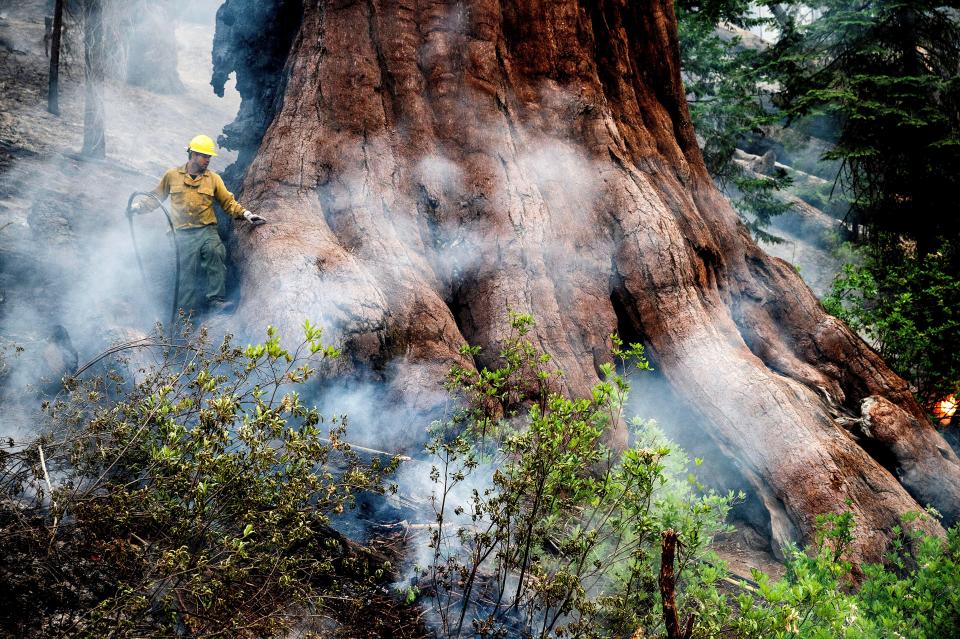What to know: Yosemite fire threatens sequoia grove, some of Earth’s oldest, biggest trees
A wildfire in Yosemite National Park is threatening some of the oldest and most massive trees on the planet, woodlands that have stood since before the founding of Rome. The iconic Mariposa Grove of Giant Sequoias, visited by a million people every year, is now closed as firefighters battle the Washburn Fire that threatens to engulf it.
What is Mariposa Grove?
This stand of trees on 248 acres is home to more than 500 mature giant sequoia trees. Some of them are estimated to be as much as 3,000 to 3,500 years old. The awe-inspiring Grizzly Giant stands 209 feet tall (more than 15 stories) and is estimated to weigh roughly 2 million pounds.
The grove has been protected since President Abraham Lincoln first signed legislation setting it aside for public use in 1864.

What's threatening it?
The Washburn Fire began July 7 and has since burned 3,221 acres in Yosemite National Park, coming perilously close to the grove. There were 649 people fighting the fire, and it was 22% contained, according to the National Park Service. It was zero percent contained on Sunday.
At a community meeting Monday evening, Yosemite Superintendent Cicely Muldoon said the fire was caused by humans.
"As you all know, there was no lightning on that day. So it’s a human start fire and it’s under investigation," Muldoon said. "That’s all I can really say about that right now. We’re looking at that real, real hard."
The fire has been so powerful the tremendous updraft from its heat is sucking branches and other debris hundreds of feet into the air. As they fall, they rain down on firefighters and airplanes attacking the blaze.
In one incident on Saturday, a more than 2-foot long tree branch was pulled several hundred feet into the air by the fire, narrowly missing two firefighting aircraft.
What's being done to protect the grove?
The National Parks Service has dug fire lines to protect the giant sequoias and is using ground-based sprinkler systems to increase humidity in the area. This requires the fire to expend more energy to burn, so the fire's intensity drops, said Craig Clements, who directs the Wildfire Interdisciplinary Research Center at San José State University.
Why do giant sequoias matter?
Giant sequoias only grow in a few small areas along the West coast. They are a relic species dating back to before the Jurassic period.
"Continents have shifted, the climate has changed multiple times and still these little pockets have survived," said Will Russell, a forest ecologist at San José State University. "Unfortunately, it looks like the current pressure of climate change is affecting them in such a way that we might lose them."
The giant sequoia is now endangered, with only 80,000 estimated to survive given high levels of logging over the past 150 years. Increasingly severe fires threaten those that remain.
"In the fire seasons of 2020 and 2021 alone, a 14-month period, we estimate we lost 19% of all giant sequoia. It's just not sustainable," said Joanna Nelson, director of science and conservation at the Save the Redwoods League.
Mariposa Grove is one of three giant sequoia groves in Yosemite. Their massive trunks can measure almost 30 feet around, as big as a house. The branches on some giant sequoias are as thick as the trunks of regular trees.
"These trees dwarf us. They've been here for up to 3,400 years and give us a sense of perspective. They are temples of nature," said Ed Smith, a senior forest ecologist with the Nature Conservancy. "There's a spiritual value to these groves."
How did sequoias survive so long?
Giant sequoias evolved to live with frequent fire, with an enveloping, cork-like bark that can be as much as 18 inches thick and insulates them from flames. Their roots go deep, protecting them from the heat pulse of wildfires.
Prior to the focus on fire suppression that began around 1900, these forests typically burned every 10 to 30 years. These small-scale fires cleared brush and needles but were relatively low intensity, allowing the sequoia to remain unharmed.
But now the buildup of fuels allows fires to burn hotter and higher. In addition, climate change has led to deeper droughts, drying out the land so it's more fire-prone.
"We’re dealing with species that have evolved over millennia, and we’re changing the rules of the game over a very short period of time and expecting them to cope with the changes we’ve fostered," Smith said. "It’s pretty unrealistic."
Are they expected to survive?
Temperatures are anticipated to warm into the 90s at Yosemite over Monday and Tuesday, which the National Parks Service says could mean increased fire activity. However, winds are predicted to be low.
"That should allow them to have pretty good containment soon," said Clements.
Contributing: Thao Nguyen, USA TODAY
This article originally appeared on USA TODAY: Yosemite fire supercharged by climate change threatens giant sequoias

